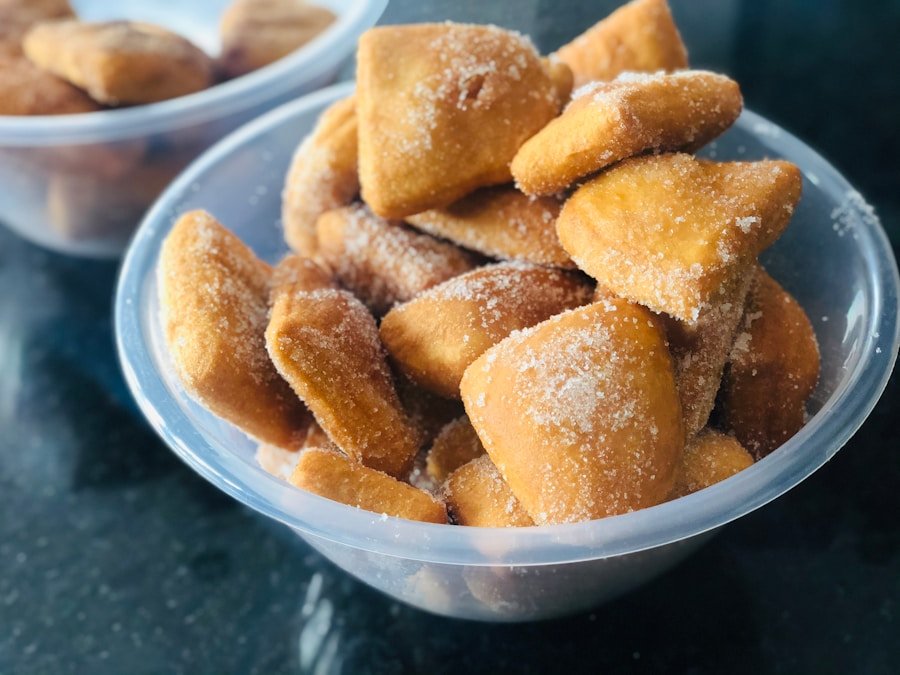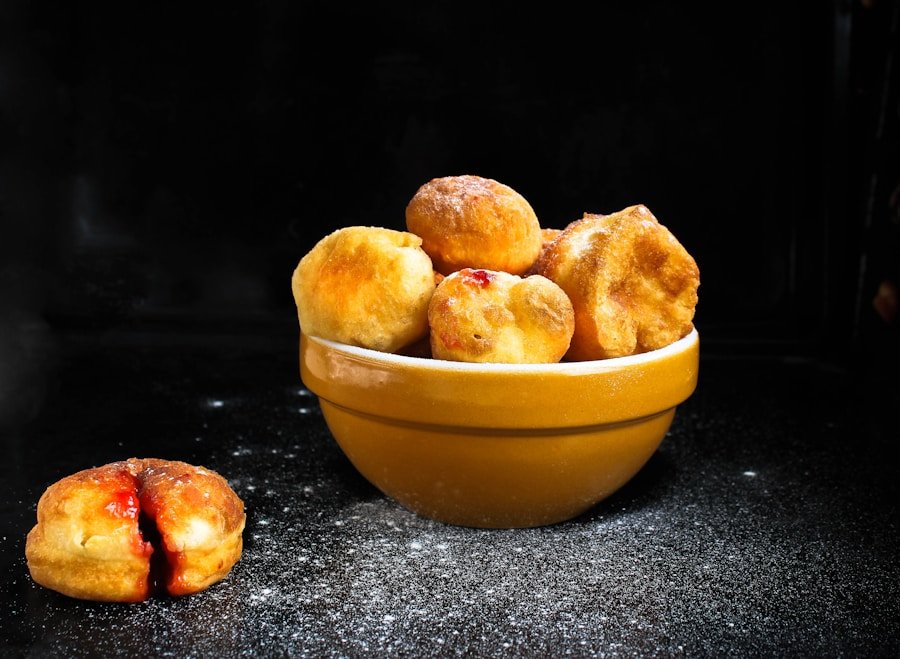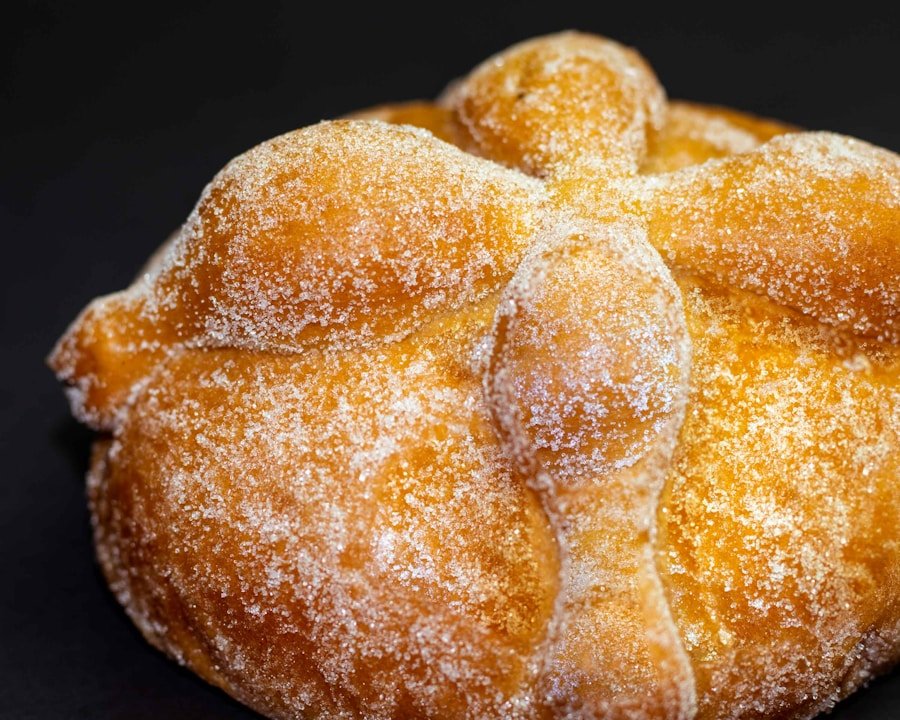Fried dough is a beloved treat that has transcended cultures and generations, often evoking nostalgia and comfort. This simple yet delightful food has roots in various culinary traditions, appearing in forms such as funnel cakes, zeppoles, and churros. The allure of fried dough lies not only in its crispy exterior and soft, pillowy interior but also in its versatility.
It can be enjoyed sweet or savory, making it a favorite at fairs, carnivals, and family gatherings. The process of frying dough transforms basic ingredients into a golden-brown delicacy that tantalizes the taste buds. The history of fried dough is as rich as its flavor.
Many cultures have their own versions of this treat, often linked to celebrations and communal gatherings. For instance, in Italy, zeppoles are traditionally served during Saint Joseph’s Day, while in the United States, funnel cakes are a staple at summer fairs. Each variation carries its own unique twist, influenced by local ingredients and culinary practices.
This article will delve into the ingredients, preparation methods, and creative variations of fried dough, providing a comprehensive guide for both novice cooks and seasoned chefs.
Key Takeaways
- Fried dough is a popular treat enjoyed in many cultures around the world, known for its crispy exterior and soft interior.
- The key ingredients for making fried dough include flour, yeast, sugar, salt, water, and oil for frying.
- To make fried dough, mix the ingredients, knead the dough, let it rise, then roll it out and fry until golden brown.
- Tips for perfecting fried dough include ensuring the oil is at the right temperature, not overcrowding the frying pan, and draining the fried dough on paper towels.
- Variations and toppings for fried dough include powdered sugar, cinnamon sugar, chocolate sauce, fruit compote, or savory options like cheese and herbs.
Ingredients for Fried Dough Recipe
Creating the perfect fried dough begins with selecting the right ingredients. The foundation of any fried dough recipe typically includes flour, water, yeast, sugar, and salt. All-purpose flour is commonly used due to its balanced protein content, which contributes to the dough’s structure.
Yeast is essential for leavening; it ferments the sugars present in the dough, producing carbon dioxide that causes the dough to rise and become airy. Sugar not only adds sweetness but also enhances browning during frying, resulting in a beautifully golden crust. In addition to these basic components, many recipes call for milk or eggs to enrich the dough.
Milk adds moisture and a subtle creaminess, while eggs contribute to the dough’s richness and help bind the ingredients together. Some variations may include baking powder as an alternative leavening agent for a quicker preparation time. Flavorings such as vanilla extract or nutmeg can also be incorporated to elevate the taste profile.
Finally, a pinch of salt is crucial; it balances the sweetness and enhances the overall flavor of the fried dough.
Step-by-Step Instructions for Making Fried Dough

To embark on your fried dough journey, begin by preparing your workspace and gathering all necessary ingredients. Start by activating the yeast if using dry yeast; combine it with warm water and a teaspoon of sugar in a bowl, allowing it to sit for about 5-10 minutes until frothy. In a separate mixing bowl, whisk together the flour and salt.
Once the yeast mixture is ready, pour it into the flour mixture along with any additional wet ingredients like milk or eggs. Knead the dough on a floured surface for about 5-10 minutes until it becomes smooth and elastic. This step is crucial as it develops gluten, which gives the dough its structure.
After kneading, place the dough in a lightly greased bowl, cover it with a clean cloth or plastic wrap, and let it rise in a warm environment for approximately one hour or until it has doubled in size. This fermentation process not only enhances flavor but also contributes to the lightness of the final product. Once the dough has risen sufficiently, punch it down to release any trapped air bubbles and turn it out onto a floured surface.
Roll it out to your desired thickness—typically about half an inch thick—before cutting it into shapes. Traditional fried dough can be made into squares or circles, but feel free to get creative with your shapes. Heat oil in a deep fryer or heavy-bottomed pot to around 350°F (175°C).
Carefully drop the cut pieces of dough into the hot oil, frying them until they are golden brown on both sides. Use a slotted spoon to remove them from the oil and drain on paper towels.
Tips for Perfecting Fried Dough
| Tips for Perfecting Fried Dough |
|---|
| 1. Use a high-quality oil with a high smoke point, such as vegetable or canola oil, for frying. |
| 2. Ensure the oil is at the correct temperature (usually around 375°F or 190°C) before adding the dough to achieve a crispy exterior. |
| 3. Allow the dough to rest and rise before frying to ensure a light and airy texture. |
| 4. Use a slotted spoon or spider strainer to carefully turn the dough while frying for even browning. |
| 5. Drain the fried dough on a paper towel-lined plate to remove excess oil. |
Achieving perfect fried dough requires attention to detail and a few key techniques. One important tip is to ensure that your oil is at the correct temperature before frying; too hot can lead to burnt exteriors while leaving the insides raw, whereas too cool can result in greasy dough that absorbs excess oil. A kitchen thermometer can be invaluable for monitoring oil temperature accurately.
If you don’t have one on hand, you can test the oil by dropping a small piece of dough into it; if it sizzles immediately and rises to the surface, you’re ready to fry. Another crucial aspect is not overcrowding the frying vessel. Frying too many pieces at once can lower the oil temperature significantly, leading to uneven cooking.
Instead, fry in small batches to maintain consistent heat throughout the process. Additionally, consider letting your fried dough rest on paper towels after frying; this will help absorb any excess oil and keep your treat from becoming overly greasy. For an extra touch of flavor, sprinkle your fried dough with powdered sugar or cinnamon sugar immediately after removing it from the oil while it’s still warm.
Variations and Toppings for Fried Dough
Fried dough is incredibly versatile and can be customized with various flavors and toppings to suit different palates. For those with a sweet tooth, consider adding chocolate chips or fruit preserves directly into the dough before frying for an indulgent twist. After frying, drizzle with chocolate sauce or caramel for an extra layer of decadence.
Cinnamon sugar is a classic topping that pairs beautifully with fried dough; simply mix granulated sugar with ground cinnamon and sprinkle generously over warm pieces. Savory variations are equally enticing; incorporating herbs like rosemary or garlic powder into the dough can create a delightful appetizer or side dish. Serve these savory versions with dips such as marinara sauce or garlic aioli for an elevated experience.
Another popular variation is to stuff fried dough with fillings like cheese or seasoned meats before frying; this method creates a delicious surprise with each bite. The possibilities are endless when it comes to experimenting with flavors and toppings.
Serving Suggestions for Fried Dough

When it comes to serving fried dough, presentation can enhance the overall experience significantly. For casual gatherings or family events, consider serving fried dough on large platters lined with parchment paper for easy cleanup. Dusting them with powdered sugar or drizzling them with icing can add visual appeal while also enticing guests with their aroma and appearance.
Pairing fried dough with fresh fruit or whipped cream can create a delightful contrast of textures and flavors. For more formal occasions or themed parties, consider creating a fried dough bar where guests can customize their treats with various toppings and dips. Set out bowls of different sauces—such as chocolate syrup, fruit compote, or honey—and an array of toppings like chopped nuts, sprinkles, or shredded coconut.
This interactive approach not only makes for an engaging experience but also allows guests to tailor their fried dough to their individual tastes.
Healthier Alternatives to Traditional Fried Dough
While traditional fried dough is undeniably delicious, there are ways to enjoy this treat with a healthier twist. One popular alternative is baking instead of frying; this method significantly reduces fat content while still delivering a satisfying texture. To achieve a similar taste profile when baking, consider using a convection oven that circulates hot air around the dough for even cooking and browning.
Another option is to use whole grain flours such as whole wheat or oat flour instead of all-purpose flour; these alternatives provide added fiber and nutrients without sacrificing flavor. Additionally, reducing sugar content or substituting natural sweeteners like honey or maple syrup can create a healthier version without compromising on taste. For those looking to avoid gluten altogether, gluten-free flours such as almond flour or coconut flour can be used effectively in fried dough recipes.
Conclusion and Final Thoughts on Fried Dough
Fried dough stands as a testament to culinary creativity across cultures and time periods. Its simplicity allows for endless variations that cater to diverse tastes and dietary preferences. Whether enjoyed at a fairground or made at home for family gatherings, this delightful treat brings joy and satisfaction to those who indulge in it.
By mastering the basic recipe and exploring various toppings and techniques, anyone can create their own version of this timeless delicacy. As you embark on your fried dough-making journey, remember that experimentation is key; don’t hesitate to try new flavors or methods that resonate with your culinary style. With practice and creativity, you’ll find that fried dough can be more than just a snack—it can become a cherished tradition in your own kitchen.
FAQs
What is a fried dough recipe?
A fried dough recipe is a type of recipe that involves making a dough, shaping it into small pieces, and then frying it in oil until it becomes crispy and golden brown.
What are the common ingredients in a fried dough recipe?
Common ingredients in a fried dough recipe include flour, water, yeast, sugar, salt, and oil for frying. Some recipes may also include milk, eggs, or flavorings such as vanilla or cinnamon.
What are some variations of fried dough recipes?
There are many variations of fried dough recipes from different cultures around the world. Some popular variations include beignets (French), churros (Spanish), zeppole (Italian), and funnel cake (American).
How is fried dough typically served?
Fried dough is often served as a sweet treat, dusted with powdered sugar, cinnamon sugar, or drizzled with honey or syrup. It can also be served with fruit compote, chocolate sauce, or whipped cream. In some cultures, fried dough is also served as a savory snack, topped with cheese, herbs, or other savory toppings.
What are some tips for making fried dough?
Some tips for making fried dough include ensuring that the oil is at the correct temperature for frying (around 375°F/190°C), allowing the dough to rest and rise before frying, and using a slotted spoon or tongs to carefully turn the dough while frying to ensure even cooking. It’s also important to drain the fried dough on paper towels to remove excess oil before serving.
